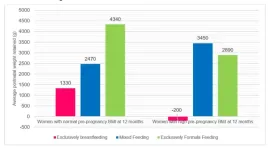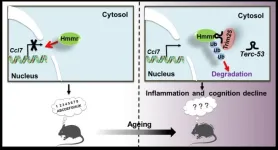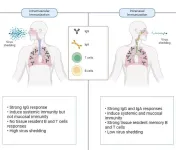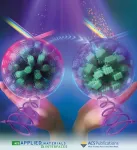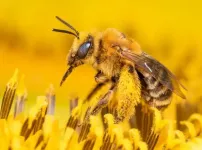(Press-News.org) Millions of women who work in the fisheries industry are being left behind as technologies develop to counter the effects of climate change and economic pressures.
New research led by the University of East Anglia (UEA) looks specifically at post-harvest fisheries and aquaculture, where women constitute 50 per cent of the total workforce. Despite their significant contributions women often remain invisible, are unpaid or underpaid, their work seen as an extension of household work.
The findings, ‘A systematic review of the impact of post-harvest aquatic food processing technology on gender equality and social justice’, are published today in Nature Food.
Fisheries and aquaculture are an important source of livelihood, food and nutrition for many of the world’s poorest, supporting worldwide about 67 million people directly and about 492 million people indirectly. Fisheries and aquaculture provide about 17 per cent of animal-source protein for human consumption, yet more than a third of global fisheries and aquaculture harvest is lost or wasted.
Prof Nitya Rao, UEA Professor of Gender & Development and Director of the Norwich Institute for Sustainable Development, is the lead author. She said: “Given the large number of people, in particular women, engaged in post-harvest activities globally, this review sought to better understand how processing technology and technical change have impacted those engaged in this sector, and how labour, resources, power and decision making are influenced and change in this process.
“In the context of climate change and other economic pressures, we are witnessing a rapid development of post-harvest technologies to enhance productivity and efficiency, reduce loss and waste, and ensure quality. Yet without addressing the social justice dimensions of these changes, there is a risk that this may exacerbate pre-existing and persistent inequalities.”
Women are disadvantaged across both traditional and improved technologies, especially regarding control over resources. Women are often unable to access social protection benefits including minimum wages, health insurance, housing and transport, due to their concentration at the lower levels of the labour hierarchy.
As enterprises expand and adopt more capital-intensive technologies, women frequently report less agency and lower equity outcomes due to a combination of resource constraints, individual characteristics such as education, social norms and care responsibilities.
In the larger-scale, factory-based settings using advanced technologies, women and migrant workers tend to have lower status; often temporary, lower-paid jobs that are culturally stereotyped as ‘women’s work’; experience gender pay gaps, lack of access to worker rights and managerial roles; and are exposed to occupational health hazards. Labour divisions are stark, reinforced by social norms.
Whilst power and control of resources is more unequal in factory settings, it is not necessarily equal in traditional contexts either, despite offering greater flexibility. While sometimes less productive, these technologies usually allow greater agency for women. Here one confronts a trade-off between enhanced productivity, income, and gender equality as seen in women’s control over resources and decision-making agency.
Dr Julie Bremner of the UK Centre for Environment, Fisheries and Aquaculture Science, and paper co-author, said: “Aquatic food is a key component of our global food system, particularly for seafood-reliant nations such as the large ocean states, and demand for aquatic products is forecast to grow. Sustainability of these foods depends not just on their environmental and economic footprints, but also on their social equity footprint.
“Our review shows there is a way to go yet on the equity element, but there are opportunities waiting to be grasped.”
The review makes several recommendations for policy, research and practice:
The focus of fisheries’ policymaking needs to embrace the entire aquatic food system, moving beyond capture fisheries and aquaculture to post-harvest processing, storage and consumption.
More rigorous and comparative research is needed to examine the impacts of a range of technologies on different groups of people including women and men, young and elderly, migrant and non-migrant, and formally consider intersectionality.
Diverse voices, especially women’s and migrant worker voices, should have a place in policymaking and investment decisions around post-harvest processes at local, national and global levels in the process of developing and rolling out improved technologies.
The research team, which included other UEA and Norwich Institute for Sustainable Development colleagues, reviewed 42 studies covering 55 locations in India, Bangladesh, Cambodia, Philippines, Japan, Canada, USA, Mexico, Brazil, Norway, Ghana, Nigeria, Tanzania and Zambia.
‘A systematic review of the impact of post-harvest aquatic food processing technology on gender equality and social justice’, is published 27 August 2024 in Nature Food.
END
Women in global fisheries industry fall through the safety net
2024-08-27
ELSE PRESS RELEASES FROM THIS DATE:
In six new rogue worlds, Webb Telescope finds more star birth clues
2024-08-27
The James Webb Space Telescope has spotted six likely rogue worlds—objects with planetlike masses but untethered from any star’s gravity—including the lightest ever identified with a dusty disk around it.
The elusive objects offer new evidence that the same cosmic processes that give birth to stars may also play a common role in making objects only slightly bigger than Jupiter.
“We are probing the very limits of the star forming process,” said lead author Adam Langeveld, an astrophysicist at Johns Hopkins University. “If you have an object that looks like a young Jupiter, is it possible that ...
Star lives and afterlives
2024-08-27
A two-faced star, a star as massive as the Sun but as compact as the Moon, and star ‘corpses’ that engulf entire planets and disrupt planetary orbits. Ilaria Caiazzo, an astrophysicist who has made stunning discoveries, joins the Institute of Science and Technology Austria (ISTA) as a new assistant professor. Her path led her from philosophy to studying stellar evolution and death while managing her broad interests including movie production.
Ilaria Caiazzo has always had a broad spectrum of interests. Her path to astrophysics started in philosophy and ...
Dungeons and Dragons can help autistic people gain confidence and find their inner hero
2024-08-27
Dungeons and Dragons is a hugely popular roleplaying game enjoyed by millions of people all over the world, both in person and online, every day.
However, new research has found it could be particularly beneficial for people with autism, giving them a safe space to engage in social interactions away from some of the challenges they face in their daily lives.
The study, published in the journal Autism, was led by researchers from the University of Plymouth’s School of Psychology along with colleagues at Edge ...
KKH study: Exclusive breastfeeding leads to greater weight loss in women with high body mass index as compared to women with normal weight
2024-08-27
27 August 2024, Singapore – A KK Women’s and Children’s Hospital (KKH) study[1] on breastfeeding practices revealed that among the women who exclusively breastfed, those with high body mass index[2] (BMI) before pregnancy lost more weight than women with a healthy BMI pre-pregnancy.
Women with high BMI who exclusively breastfed, in addition to losing their pregnancy weight, lost an extra 200 grammes on average, 12 months after childbirth. Women with normal BMI who exclusively breastfed lost weight ...
Noncoding RNA Terc-53 and hyaluronan receptor Hmmr regulate aging in mice
2024-08-27
The authors investigate the physiological functions of Terc-53 by creating transgenic mice that overexpress this noncoding RNA. They observe that Terc-53 overexpression affects normal aging in mammals, contributing to cognitive decline and shortened lifespan. Mechanistically, they find that Terc-53 binds to and promotes the degradation of Hmmr, leading to enhanced inflammation in tissues and accelerated aging. They also note that Hmmr levels decrease with age in certain brain regions, similar to Terc-53's pattern, and that restoring Hmmr levels can improve cognitive abilities ...
Game-changing needle-free COVID-19 intranasal vaccine
2024-08-27
A next-generation COVID-19 mucosal vaccine is set to be a gamechanger not only when delivering the vaccine itself, but also for people who are needle-phobic.
New Griffith University research, published in Nature Communications, has been testing the efficacy of delivering a COVID-19 vaccine via the nasal passages.
Professor Suresh Mahalingam from Griffith’s Institute for Biomedicine and Glycomics has been working on this research for the past four years.
“This is a live attenuated intranasal vaccine, called CDO-7N-1, designed ...
Preventing counterfeiting by adding dye to liquid crystals to create uncrackable coded tags
2024-08-27
A research group led by Nagoya University has developed an innovative approach to creating anti-counterfeiting labels for high-value goods. Their findings, published in ACS Applied Materials & Interfaces, enhance the security of the currently used cholesteric liquid crystals (CLCs) by adding fluorescent dyes to produce florescent CLCs (FCLCs).
Using this unique technology, the group created unique labels with almost impossible-to-counterfeit security features. These advanced labels are designed to protect valuable items, important documents, and sensitive products ...
Beckman announces 2024 research seed grant awardees
2024-08-27
The Beckman Institute for Advanced Science and Technology funded two research projects in 2024 as part of its research seed grant program. The program supports interdisciplinary research projects and is now in its second year.
This year, two research projects beginning in May 2024 received $75,000 per year for up to two years.
Research projects seeded by the Beckman Institute anticipate growth and typically lead to external funding proposals after the two-year seeding term.
Exploring how ASD-related genes influence brain networks that guide behavior
The CDC estimates that “1 in 36 children has been identified with autism spectrum disorder,” or ASD.
ASDs ...
Are crops worldwide sufficiently pollinated?
2024-08-27
A team of researchers led by Rutgers University-New Brunswick scientists has analyzed crop yields of more than 1,500 fields on six continents, and found that production worldwide of important, nutritionally dense foods such as fruits, vegetables, nuts and legumes is being limited by a lack of pollinators.
The results, detailed in Nature Ecology & Evolution, showed that across diverse crops and locations, one-third to two-thirds of farms contain fields that aren’t producing at the levels they should be due to a lack of pollinators. The phenomenon of a low crop yield because of insufficient visits by insects is known as pollinator limitation.
The ...
American Meteorological Society announces 2025 weather, water, and climate honorees
2024-08-27
The American Meteorological Society is proud to announce its 2025 Awards and Honors, recognizing outstanding contributions to the weather, water, and climate community. 2025 recipients will be honored at the 105th AMS Annual Meeting in New Orleans, 12–16 January, 2025.
“One of our key priorities at AMS is to recognize the work of our global weather, water, and climate enterprise for the impact they have on scientific advancement and public safety, as well as on economic growth for all communities,” says Awards Oversight Committee Chair ...


